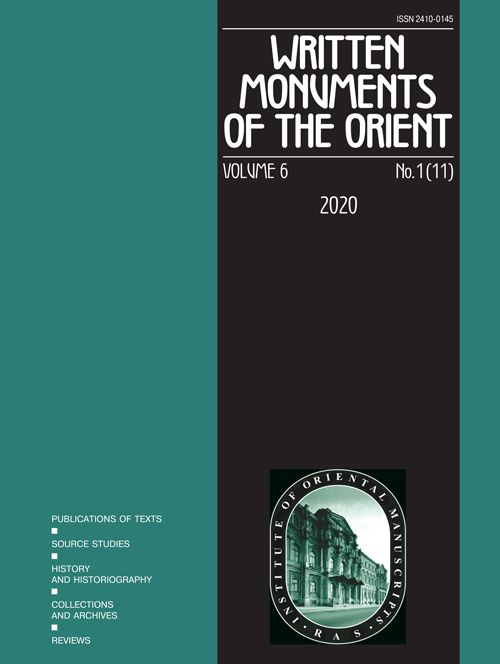Том 6, № 1 (2020)
- Год: 2020
- Выпуск опубликован: 25.08.2020
- Статей: 8
- URL: https://journals.eco-vector.com/2410-0145/issue/view/1985
- DOI: https://doi.org/10.17816/wmo.61
Весь выпуск
Original Papers
A Unique Tangut Primary Reader Brief Collection by Taizong kept in the IOM RAS
Аннотация
The previously undesiphered manuscript inv. № 5875 preserved in the Institute of Oriental Manuscripts, Russian Academy of Sciences, proves to be the Tangut version of a primary reader. Its Chinese original is an inconsistently miscellaneous compilation of ancient literary allusions and contemporary folk maxims. The text is composed by different literary style of antithetical couplet and ordinary prose without a consistent subject. Although its Chinese original has not been found yet and the whole text has not been thoroughly deciphered so far, narrations and translations may be provided as many as possible in the present paper in order to lay a foundation for further studies.
 3-38
3-38


A Document from Tangut Regarding the Lease of a Bakery
Аннотация
The paper is focused on the study of Document Дх-18993 “Agreement on a Bakery Lease to Li Chungou and others, drawn as a result of a contest of tenders conducted in the 1st month of the 12th year of the Guangding reign era” kept in the Institute of Oriental manuscripts of the RAS. The writer of the paper proves that the document originates from Khara-Khoto and gives the comments on its content.
 39-46
39-46


The first leaf of an Old Uyghur 觀無量壽經 Guanwuliangshoujing translation
Аннотация
The paper discusses the 觀無量壽經 Guanwuliangshoujing (T. 365) in Old Uyghur. It is an important text of the Pure Land Buddhism known only in its original Chinese text. Several separated fragments in Old Uyghur are known. One fragment of the Turfan Collection in Berlin (U 1499) can be joined with a leaf of the Serindia Collection of the IOM (SI 1748). The result is presented here. One of its interesting differences is the list of 15 Bodhisattvas of which only Mañjuśrī is given by name in the Chinese original.
 47-55
47-55


A fragment of a Tocharian B text concerning the conversion of Uruvilvā-Kāśyapa
Аннотация
This article is a full edition of two fragments of a Tocharian B manuscripts kept in the Petrovsky sub-collection of the Serindian Collection of the IOM RAS with a text of Buddhist content related to the conversion of Uruvilvā-Kāśyapa. The article provides the full transliteration and transcription of the text, as well as the provisional translation. Assumptions are made regarding the Sanskrit and Tocharian B literature parallels.
 56-70
56-70


An Analysis of Manhan huangyu shanhe diming kao 滿漢皇輿山河地名考 — A Bilingual Manchu and Chinese Study of Mountain and River Toponyms of the Imperial Territories
Аннотация
Manhan huangyu shanhe diming kao 滿漢皇輿⼭山河地名考 “A Study of Mountain and River Toponyms of the Imperial Territories” is a Manchu and Chinese bilingual manuscript on geography in the collection of the National Library of China. It is a collection of toponyms covering the northeastern territory of the Qing and includes a brief description of the military achievements before the Manchu conquest of the central plains. In this paper I argue that this text is closely related to the Shengjing Jilin Heilongjiang deng chu biaozhu zhanji yutu 盛京吉林黑龍江等處標注戰跡輿圖 “Map of Military Deeds in Shengjing, Jilin, Heilongjiang,” and that its dating on the title page to the Qianlong gengchen nian 乾隆庚辰年 “white dragon year of Qianlong (1760)” is not actually the date of this manuscript’s composition. The phrase of huangyu (the imperial territories) refers in the context of this work to the territory of the Qing before 1644.
 71-87
71-87


Newly Found Dunhuang Fragments of Śatasāhasrikā Prajñāpāramitā in the Collection of the IOM, RAS
Аннотация
the paper presents eleven fragments of Śatasāhasrikā Prajñāpāramitā identified during analysis of Khara-khoto collection of Tibetan texts kept in the IOM, RAS. In 2019 as an intermediate result of a project ‘Compilation of the Catalogue of the Tibetan texts from Khara-Khoto preserved at the Institute of Oriental Manuscripts, RAS’ being done by researchers of the institute thirty-three fragments that had been added to Khara-khoto collection by mistake, were transferred to a separate collection of Tibetan texts from Dunhuang. Although the edited fragments of Śatasāhasrikā Prajñāpāramitā cannot be considered to be unique they are worth studying in terms of codicology.
 88-102
88-102


Secular Fragments of Tibetan Texts found at the Main Dunhuang Collection Kept at the IOM, RAS
Аннотация
The paper introduces twelve fragments of secular texts in Tibetan found in the main collection of Dunhuang manuscripts preserved in the IOM, RAS. In regard of each fragment a physical description, provisional notes on their contents, digital copy and transliteration are provided. Since all the fragments are very short our identifications of the texts are just tentative. One of them, Дх-7759, relates to the divination with dice. The others are fragments of letters, economic documents, etc.
 103-116
103-116


Letters by J.P.A. Rémusat to Schilling von Canstadt (1817–1829) in the Orientalists Archives of the Institute of Oriental Manuscripts, Russian Academy of Sciences
Аннотация
The paper documents the relationship between the inventor, printer and collector of Oriental books P.L. Schilling von Canstadt and the Orientalist J.P. Abel Rémusat by means of their extant correspondence. The bibliophile with a splendid Oriental library was a welcome partner and correspondent as he could and often would help colleagues with his rarities not to be found anywhere else in Europe. His expertise in printing Oriental scripts was attractive, too, as Orientalists were in need of adding Oriental scripts to their publications. Rémusat, on the other hand, wrote evaluations for the Petersburg dictionary project and publicized Schilling’s Chinese publications as models of perfect printing art. There is also a memo from Fr. Gass to Schilling, which gives some details about their printing experiments.
 117-143
117-143












